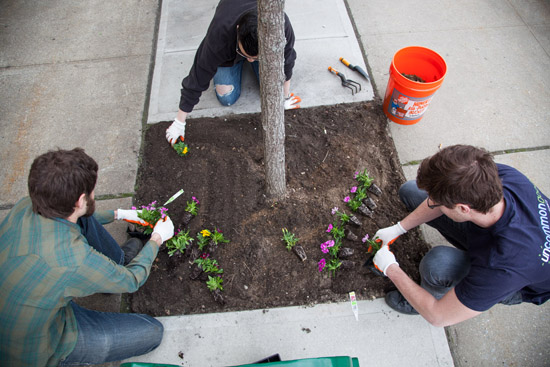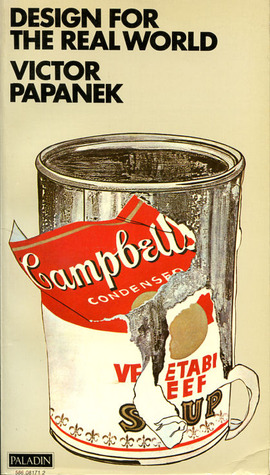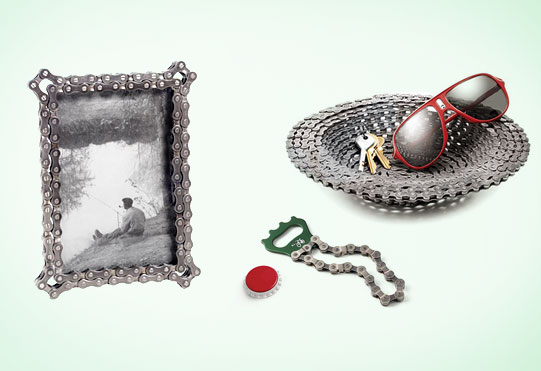As Earth Day celebrates its 45th anniversary this year, it’s hard to believe that the concept of “going green” is still relatively new. While we’ve come a long way as individuals to evaluate our environmental impact, the countless designs that we interact with on a daily basis have, too.

The UncommonGoods team planting flowers for Earth Day.
In the decades prior to the establishment of Earth Day, the manufacturing industry was more interested in making green than going green: factories belched out clouds of black smoke; toxic chemicals were dumped carelessly, polluting the soil and groundwater; and bottles, cans, and paper were all destined for the landfill after just one use. At the time, most people remained blissfully unaware of the consequences of overconsumption and how negligent manufacturing practices were wreaking havoc on the planet.
After witnessing the ravages of the 1969 oil spill in Santa Barbara, California, Wisconsin senator Gaylord Nelson had the idea of bringing environmental issues to the public eye by creating an event infused with the same energy as the anti-war protests occurring at the time. On April 22nd, 1970, his simple idea for a teach-in exploded into a national event uniting 20 million people under one common goal: raise awareness about environmental impact. The little holiday that could led to the creation of the United States Environmental Protection Agency and the passage of the Clean Air, Clean Water, and Endangered Species Acts.
During the same era of change, Vienna-born designer Victor Papanek quietly penned his cri de coeur, Design for the Real World: Human Ecology and Social Change, an impassioned plea for reform that laid the foundation for the emerging sustainable and humanitarian design movements.
Design for the Real World: Human Ecology and Social Change, Paperback, Second Edition, Published August 30th 2005 by Chicago Review Press (first published 1972), image via Goodreads
“There are professions more harmful than industrial design, but only a few,” he writes at the start of his 1971 manifesto. In addition to pillorying his peers for producing shoddy, stylized work that wasted natural resources and aggravated the environmental crisis, he also introduced the idea of socially responsible design. Calling designers “the handmaidens of capitalism,” Papanek advocated for a triple bottom line policy, in which people, planet, and profit are interconnected and should be considered together.
UncommonGoods Founder & CEO Dave Bolotsky meeting with artisans in India.
To Papanek, ecological and social responsibility are the twin pillars of the design practice and his advice has gone on to influence a generation of designers as well as businesses like ours. As a founding B Corp, we meet rigorous standards of social and environmental performance, accountability, and transparency. We’re also proud to support designers with a similar agenda, who make it their business to come up with better design solutions for people and the planet.
Reclaimed Bike Chain designs by Graham Bergh
In 1991, after getting a flat tire while riding his bike, Graham Bergh was inspired to salvage the materials to make something new and totally unexpected. Every year, his team of bicycle craftsmen collects thousands of pounds of used parts, drawing from bike shops nationwide, and revives them into creative home accents.
Graffiti Jewelry Collection by Amy Peterson and Diana Russell
After encountering the crumbling walls of graffiti throughout Detroit, Amy Peterson and Diana Russell found the inspiration to turn these bits of urban detritus from around the Motor City into one-of-a-kind remnants of its vibrant street-art scene. Together, they work with women from local shelters to create beautiful works of art that also have a beautiful mission to improve the lives of the people in the community.
Edgar and Ollie the Puppet Pals by Jen List and Stacey Waddington
When Jen List and Stacy Waddington stumbled upon a heap of unwanted sweaters and shirts, the duo decided to transform the old fabrics into a line of snuggly and imaginative children’s toys and accessories that encourage early learning and individual expression through creative design, wonder, and storytelling.
How do you plan on celebrating Earth Day, and what “green” practices do you incorporate into your life?






1 Comment
[…] the manufacturing industry touches almost everything we use. As you may have read in our latest Uncommon Design School post, in the decades preceding the first Earth Day “the manufacturing industry was more […]